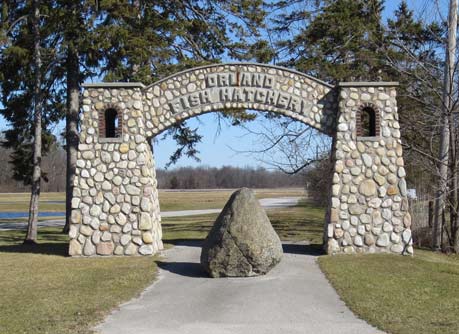
6889 N. SR 327
Orland, IN 46776
260-829-6241
Hours: 8 am - 4:30 pm, M-F.
on.IN.gov/fawnriver-sfh
Get Directions
Fawn River Fish Hatchery is located one mile north of the town of Orland on S.R. 327. The office is open from 7:30 a.m. to 3:30 p.m., Monday through Friday. The District 2 Fish Management Biologist’s office is also located at Fawn River State Fish Hatchery. The property grounds are open to the public from sunrise to sunset, seven days a week.
- Fish Production Facilities
In 1933, the Orland Conservation Club constructed a fish rearing pond in an old mill race north of town. Later, this modest fish rearing facility was to become one of Indiana’s larger fish hatcheries.
On April 25, 1935, the Orland town board purchased a tract of land adjacent to the mill race. Part of the land was to be used for the construction of a fish hatchery and the balance for a park and recreation area. Labor and part of the funds for improving the property were obtained from the FERA, a federal relief agency. The remaining funds were obtained from the town coffers. The hatchery, completed in 1937, was called the Orland Fish Hatchery and consisted of four earthen ponds ranging in size from 2.07 to 3.37 acres. The town treasury was reimbursed by the Department of Conservation (now called the Department of Natural Resources) for fish reared by the conservation club and stocked into public waters.
November 6, 1939, the town board and the Orland Conservation Club donated the hatchery to the state of Indiana, and it was immediately expanded on land purchased by the DNR. Six more rearing ponds were constructed, bringing the total water area to 23.54 acres. Today, the hatchery known as the Fawn River State Fish Hatchery consists of 14 ponds. The ponds have a total surface area of nearly 22.5 acres of water and are situated on a 43-acre parcel of land. In addition, the hatchery has six indoor tanks used for rearing and holding fish, two egg incubation units, a service/office building, an equipment storage barn, and a residence building for the manager.
In 1996, the property was placed on the National Register of Historic Sites.
Indiana state fish hatcheries do not sell fish.
- Fish Culture and Production
- Winter Activities
- Self-Guided Tours
- Volunteer Opportunities
